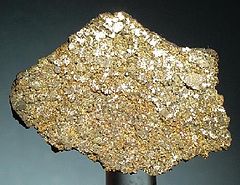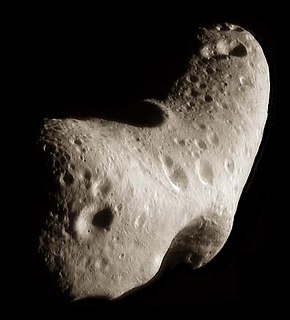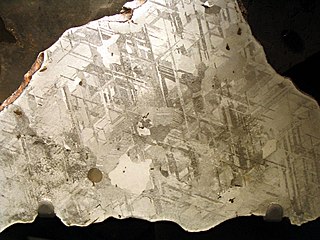
Kamacite is an alloy of iron and nickel, which is found on Earth only in meteorites. The proportion iron:nickel is between 90:10 and 95:5; small quantities of other elements, such as cobalt or carbon may also be present. The mineral has a metallic luster, is gray and has no clear cleavage although its crystal structure is isometric-hexoctahedral. Its density is about 8 g/cm3 and its hardness is 4 on the Mohs scale. It is also sometimes called balkeneisen.
The ultimate goal of meteorite classification is to group all meteorite specimens that share a common origin on a single, identifiable parent body. This could be a planet, asteroid, Moon, or other current Solar System object, or one that existed some time in the past. However, with a few exceptions, this goal is beyond the reach of current science, mostly because there is inadequate information about the nature of most Solar System bodies to achieve such a classification. Instead, modern meteorite classification relies on placing specimens into "groups" in which all members share certain key physical, chemical, isotopic, and mineralogical properties consistent with a common origin on a single parent body, even if that body is unidentified. Several meteorite groups classified this way may come from a single, heterogeneous parent body or a single group may contain members that came from a variety of very similar but distinct parent bodies. As such information comes to light, the classification system will most likely evolve.

A Chondrule is a round grain found in a chondrite. Chondrules form as molten or partially molten droplets in space before being accreted to their parent asteroids. Because chondrites represent one of the oldest solid materials within the Solar System and are believed to be the building blocks of the planetary system, it follows that an understanding of the formation of chondrules is important to understand the initial development of the planetary system.

Carbonaceous chondrites or C chondrites are a class of chondritic meteorites comprising at least 8 known groups and many ungrouped meteorites. They include some of the most primitive known meteorites. The C chondrites represent only a small proportion (4.6%) of meteorite falls.

Iron meteorites are meteorites that consist overwhelmingly of an iron–nickel alloy known as meteoric iron that usually consists of two mineral phases: kamacite and taenite. Iron meteorites originate from cores of planetesimals.

The L type ordinary chondrites are the second most common group of meteorites, accounting for approximately 35% of all those catalogued, and 40% of the ordinary chondrites. The ordinary chondrites are thought to have originated from three parent asteroids, with the fragments making up the H chondrite, L chondrite and LL chondrite groups respectively.

The LL chondrites are a group of stony meteorites, the least abundant group of the ordinary chondrites, accounting for about 10–11% of observed ordinary-chondrite falls and 8–9% of all meteorite falls. The ordinary chondrites are thought to have originated from three parent asteroids, with the fragments making up the H chondrite, L chondrite and LL chondrite groups respectively. The composition of the Chelyabinsk meteor is that of a LL chondrite meteorite. The material makeup of Itokawa, the asteroid visited by the Hayabusa spacecraft which landed on it and brought particles back to Earth also proved to be type LL chondrite.

Pultusk is an H5 ordinary chondrite meteorite which fell on 30 January 1868 in Poland. The event has been known as the stony meteorite shower with the largest number of pieces yet recorded in history. Made up of rocky debris, it consists of pyroxene or olivine chondrules deployed in mass plagioclase, there being also kamacite.
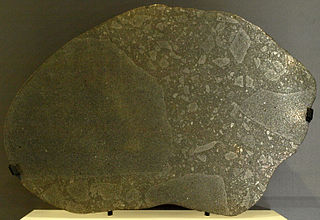
Enstatite chondrites are a rare form of meteorite thought to comprise only about 2% of the chondrites that fall on Earth. Only about 200 E-Type chondrites are currently known.
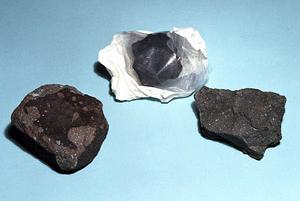
CI chondrites, sometimes C1 chondrites, are a group of rare stony meteorites belonging to the carbonaceous chondrites. Samples have been discovered in France, Canada, India, and Tanzania. Compared to all the meteorites found so far, their chemical composition most closely resembles the elemental distribution in the sun's photosphere.
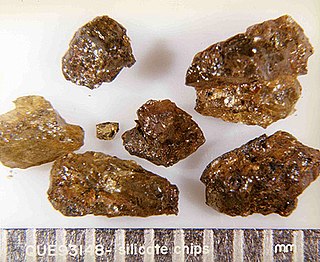
Lodranites are a small group of primitive achondrite meteorites that consists of meteoric iron and silicate minerals. Olivine and pyroxene make up most of the silicate minerals. Like all primitive achondrites lodranites share similarities with chondrites and achondrites.

Brachinites are a group of meteorites that are classified either as primitive achondrites or as asteroidal achondrites. Like all primitive achondrites, they have similarities with chondrites and achondrites. Brachinites contain 74 to 98% (Volume) olivine.
The Itqiy meteorite is an enstatite-rich stony-iron meteorite. It is classified as an enstatite chondrite of the EH group that was nearly melted and is therefore very unusual for that group. Other classifications have been proposed and are an ongoing scientific debate.
This is a glossary of terms used in meteoritics, the science of meteorites.
Mason Gully is an ordinary chondrite of subclass H5, and is the second meteorite to be recovered using the Desert Fireball Network (DFN) camera observatory. One stone weighing 24.5g was observed to fall by the Desert Fireball Network observatory in Western Australia on 13 April 2010 at 10h36m10s UTC. It was recovered by the DFN on 3 November 2010, and was found 150m from its predicted fall location based upon the observed trajectory and calculated mass.
Asteroidal water are water or water precursor deposits such as hydroxide (OH−) that exist in asteroids. The "snow line" of the Solar System lies outside of the main asteroid belt, and the majority of water is expected in minor planets (e.g., Kuiper belt objects and Centaurs. Nevertheless, a significant amount of water is also found inside the snow line, including in near-earth objects.
